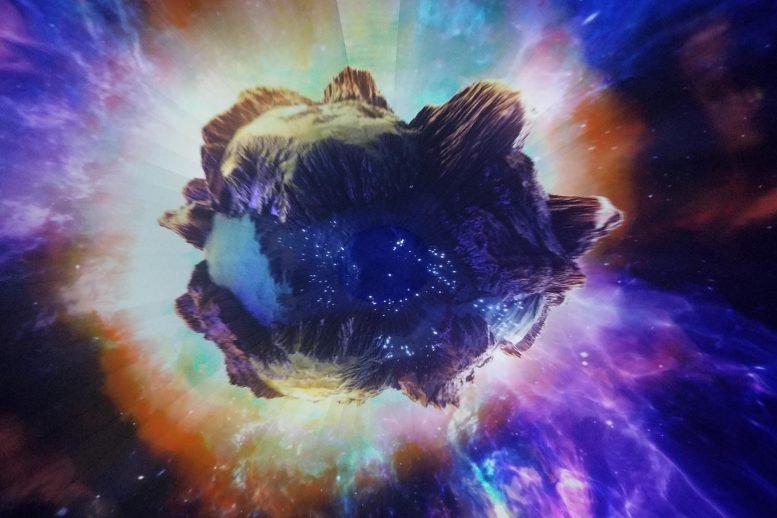
An international study reveals that certain organic compounds (PAHs) found in the Ryugu asteroid and Murchison meteorite likely originated in the cold areas of space. This finding, derived from controlled burns of plants and comparative analysis, challenges previous beliefs and offers new insights into the chemistry of celestial bodies and the potential for extraterrestrial life.
The examination of organic compounds known as polycyclic aromatic hydrocarbons (PAHs), obtained from the Ryugu asteroid and Murchison meteorite, reveals that some PAHs probably originated in the cold regions of space between stars, contrary to the earlier belief that they formed near hot star areas. These results open up new possibilities in exploring extraterrestrial life and the chemistry of objects in space.
The only Australian members of an international research team, scientists from Curtin’s WA-Organic and Isotope Geochemistry Centre (WA-OIGC) carried out controlled burnings of plants to produce PAHs.
ARC Laureate Fellow John Curtin Distinguished Professor Kliti Grice, director of WA-OIGC, said PAHs are organic compounds made up of carbon and hydrogen that are common on Earth but are also found in celestial bodies like asteroids and meteorites.
Controlled Burn Experiments
“We performed controlled burn experiments on Australian plants, which were isotopically compared to PAHs from fragments of the Ryugu asteroid that were returned to Earth by a Japanese spacecraft in 2020, and the Murchison meteorite that landed in Australia in 1969. The bonds between light and heavy carbon isotopes in the PAHs were analyzed to reveal the temperature at which they were formed,” Professor Grice said.
“Select PAHs from Ryugu and Murchison were found to have different characteristics: the smaller ones likely in cold outer space, while bigger ones probably formed in warmer environments, like near a star or inside a celestial body.”
Study co-author Dr Alex Holman, also from WA-OIGC, said understanding the isotopic composition of PAHs helps unravel the conditions and environments in which these molecules were created, offering insights into the history and chemistry of celestial bodies like asteroids and meteorites.
“This research gives us valuable insights into how organic compounds form beyond Earth and where they come from in space,” Dr Holman said.
“The use of high-tech methods and creative experiments has shown that select PAHs on asteroids can be formed in cold space.”
Reference: “Polycyclic aromatic hydrocarbons in samples of Ryugu formed in the interstellar medium” by Sarah S. Zeichner, José C. Aponte, Surjyendu Bhattacharjee, Guannan Dong, Amy E. Hofmann, Jason P. Dworkin, Daniel P. Glavin, Jamie E. Elsila, Heather V. Graham, Hiroshi Naraoka, Yoshinori Takano, Shogo Tachibana, Allison T. Karp, Kliti Grice, Alex I. Holman, Katherine H. Freeman, Hisayoshi Yurimoto, Tomoki Nakamura, Takaaki Noguchi, Ryuji Okazaki, Hikaru Yabuta, Kanako Sakamoto, Toru Yada, Masahiro Nishimura, Aiko Nakato, Akiko Miyazaki, Kasumi Yogata, Masanao Abe, Tatsuaki Okada, Tomohiro Usui, Makoto Yoshikawa, Takanao Saiki, Satoshi Tanaka, Fuyuto Terui, Satoru Nakazawa, Sei-ichiro Watanabe, Yuichi Tsuda, Kenji Hamase, Kazuhiko Fukushima, Dan Aoki, Minako Hashiguchi, Hajime Mita, Yoshito Chikaraishi, Naohiko Ohkouchi, Nanako O. Ogawa, Saburo Sakai, Eric T. Parker, Hannah L. McLain, Francois-Regis Orthous-Daunay, Véronique Vuitton, Cédric Wolters, Philippe Schmitt-Kopplin, Norbert Hertkorn, Roland Thissen, Alexander Ruf, Junko Isa, Yasuhiro Oba, Toshiki Koga, Toshihiro Yoshimura, Daisuke Araoka, Haruna Sugahara, Aogu Furusho, Yoshihiro Furukawa, Junken Aoki, Kuniyuki Kano, Shin-ichiro M. Nomura, Kazunori Sasaki, Hajime Sato, Takaaki Yoshikawa, Satoru Tanaka, Mayu Morita, Morihiko Onose, Fumie Kabashima, Kosuke Fujishima, Tomoya Yamazaki, Yuki Kimura and John M. Eiler, 21 December 2023, Science.
DOI: 10.1126/science.adg6304
>>> Read full article>>>
Copyright for syndicated content belongs to the linked Source : SciTechDaily – https://scitechdaily.com/analysis-of-organic-compounds-extracted-from-ryugu-asteroid-opens-new-possibilities-in-extraterrestrial-life-search/










